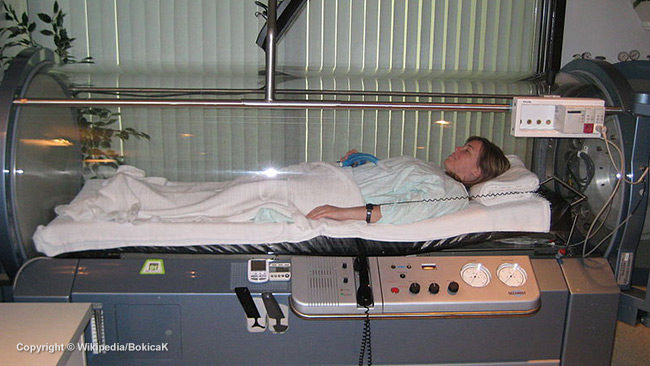With Hyperbaric Oxygen Therapy (HBOT) being increasingly used to treat several medical conditions, people are becoming more aware of this treatment option, and want to understand every aspect of it. People who have been suggested to undergo HBOT by physicians, often have many questions and doubts about the therapy.
If you are one of those willing to undergo HBOT, here are the answers to some of the questions you may want to ask about the therapy:
1. What is HBOT?
Hyperbaric Oxygen Therapy (HBOT) involves oxygen’s medical use in pressurized environment, at greater than 1 atmosphere absolute (ATA). Because of increased pressure, oxygen dissolves and saturates more effectively in blood, primarily in the plasma, which is independent of hemoglobin. This results in various positive cellular, biochemical and physiological effects. HBOT is a non-invasive therapy, and is the most reliable method of increasing levels of oxygen to body’s organs. The treatment usually lasts for about 60-90 minutes, and the patient breathes normally while lying down at the time of treatment. A single session of Hyperbaric Oxygen Therapy boosts the blood system’s oxygenation by 50%, and is equivalent to about 1,400mg Motrin excluding the toxicity.
2. What are the benefits of HBOT?
-
Reduces tissue hypoxia
Optimal functioning of cells can be achieved by heightening tissue oxygenation. Increased oxygen generates increased energy for improved tissue regeneration and accelerated tissue repair. Hypoxic tissue (low levels of oxygen) may cause cell death, and is common in most of the major health issues including heart attack, stroke, diabetes, cancer and more. By enhancing the oxygen levels, the body can be provided with increased cellular aid for preventing and treating pathophysiological events.
-
Creates new capillaries and blood vessels
New collateral flow of blood created by body is called angiogenesis or vascularization. This is especially vital for damaged regions of the body, where circulation is compromised, which may result in stroke, heart attack, non-healing wounds and more.
-
Decreases inflammation
This happens by the decrease in pro-inflammatory cytokines (small proteins released by cells to indicate inflammation) for ameliorating both chronic and acute inflammatory conditions. With the blood system’s oxygen being more, blood vessels can limit their flow (vasoconstriction) to the damaged tissue and decrease the fluid build up (edema or swelling), without compromising the greater levels of oxygen required for repair.
-
Oxygen is anti-infectious
Oxygen has the capacity to destroy harmful viruses and bacteria, while boosting the natural defense activity of white blood cells simultaneously.
-
Promotes mobilization of stem cells
HBOT has the potential to mobilize stem cells (new cells ready for becoming active cells in the body, like liver cell, brain cell, etc.) to improve repair and functionality of tissues.
-
Ameliorates neurological issues
HBOT is unique as compared to other therapies employed for neurological conditions and brain injuries. It’s the only known treatment that can increase the levels of oxygen in the brain significantly, which encourages accelerated recovery and repair. HBOT has been an effective therapy for the following 3 categories of neurological disorders:
-
Neuro-developmental disorders (Autism, Cerebral Palsy and Fetal Alcohol Syndrome)
-
Neurological injuries (Traumatic brain injuries and stroke)
-
Neuro-degenerative disorders (Alzheimer’s, Huntington’s and Parkinson’s diseases)
3. For which medical conditions is HBOT approved by FDA as a treatment?
-
Air or gas embolism
-
Carbon monoxide poisoning
-
Gas gangrene
-
Crush injury
-
Decompression sickness
-
Arterial insufficiencies
-
Severe anemia
-
Intracranial abscess
-
Necrotizing soft tissue infections
-
Osteomyelitis
-
Delayed radiation injury
-
Compromised skin flaps and grafts
-
Thermal burn injury
-
Idiopathic sudden sensorineural hearing loss
4. What are the side effects of HBOT?
Hyperbaric oxygen therapy is tolerated well by most patients. However, some common side effects may occur that are given below:
-
Temporary visual changes:
The patient may experience a slight worsening or improvement in vision during the treatment course. Vision would return to what it was before the treatment, after the treatment course is completed.
-
Fullness in ears:
With the pressurizing of the hyperbaric chamber, the patient may experience a fullness or “popping” in the ears. That sensation is temporary, and the patient is instructed about methods to clear the ears. The ear pressure can be equalized with techniques like yawning or chewing gum.
-
Increase in opaqueness of cataracts existing from before:
If the patient has cataracts, he/she should discuss about the likelihood of heightened opaqueness with his/her ophthalmologist.
Apart from these questions, there are many other questions that you may have about hyperbaric oxygen therapy, hyperbaric chambers, and various other aspects of HBOT. The internet has many resources that can help you get a sound idea about HBOT. However, your doctor is the best person who can explain you everything you need to know about the therapy, before you undergo it. Make sure you clarify all your doubts by discussing with your doctor or physician.





